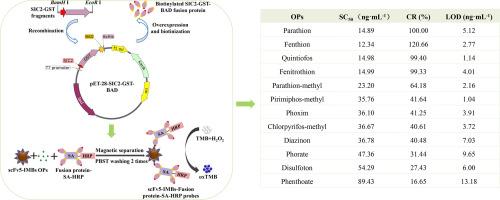Biotinylated fusion protein-streptavidin-peroxidase complex based non-competitive magnetic immunoassay for rapid detection of organophosphorus pesticides
IF 3.7
Q1 CHEMISTRY, ANALYTICAL
引用次数: 0
Abstract
Phage-displayed anti-immunocomplex peptide-based non-competitive immunoassays have shown great potential for detecting organophosphorus pesticide (OPs) residues. However, the phage-borne peptides raise safety concerns and require secondary reagents, which limit their commercial application. To address these challenges, a new approach has been developed. This study employed the SIC2 peptide, which recognized the immune complex of single-chain variable fragment 5 (scFv5) and OPs, to reveal its potential for detecting OPs residues. The SIC2 peptide was fused with glutathione S-transferase (GST) and biotin acceptor domain (BAD) genes. These fusion constructs were expressed in Escherichia coli BL21 (DE3) and then biotinylated. The biotinylated fusion protein bound to streptavidin-horseradish peroxidase (SA-HRP) conjugates through the biotin-streptavidin system, enhancing the detection signal via the catalytic oxidation of 3,3′,5,5′-tetramethylbenzidine (TMB). Based on this, and using immunomagnetic beads, a rapid non-competitive magnetic immunoassay (NCMIA) was developed for detecting OPs. The results showed that under optimal conditions, the limits of detection (LODs) for 12 OPs ranging from 1.04 to 13.18 ng mL-1, and the incubation time of this assay needed 11 min. The intra- and inter-batch recovery rates of 3 OPs in cucumber, cabbage and lettuce ranged from 79.91 % to 103.72 %, with coefficients of variation ranging from 0.26 % to 14.98 %. In addition, the recoveries of parathion determined by NCMIA were consistent with the results of parallel analyses using gas chromatography tandem mass spectrometry (GC–MS/MS).

基于生物素化融合蛋白-链亲和素-过氧化物酶复合物的非竞争磁免疫法快速检测有机磷农药
基于噬菌体抗免疫复合物肽的非竞争性免疫检测方法在检测有机磷农药残留方面显示出巨大的潜力。然而,噬菌体携带的肽引起了安全性问题,并且需要二级试剂,这限制了它们的商业应用。为了应对这些挑战,我们开发了一种新的方法。本研究利用识别单链可变片段5 (scFv5)和OPs免疫复合物的SIC2肽,揭示其检测OPs残基的潜力。SIC2肽与谷胱甘肽s -转移酶(GST)和生物素受体结构域(BAD)基因融合。这些融合构建物在大肠杆菌BL21 (DE3)中表达,然后进行生物素化。结合链霉亲和素-辣根过氧化物酶(SA-HRP)的生物素化融合蛋白通过生物素-链霉亲和素系统结合,通过催化氧化3,3 ',5,5 ' -四甲基联苯胺(TMB)增强检测信号。在此基础上,利用免疫磁珠,建立了一种检测OPs的快速非竞争磁免疫分析法(NCMIA)。结果表明,在最佳条件下,12种OPs的检出限(lod)为1.04 ~ 13.18 ng mL-1,培养时间为11 min。3种OPs在黄瓜、白菜和生菜中的批内和批间回收率为79.91% ~ 103.72%,变异系数为0.26% ~ 14.98%。此外,NCMIA测定的对硫磷回收率与气相色谱-串联质谱(GC-MS /MS)平行分析结果一致。
本文章由计算机程序翻译,如有差异,请以英文原文为准。
求助全文
约1分钟内获得全文
求助全文

 求助内容:
求助内容: 应助结果提醒方式:
应助结果提醒方式:


